Seasonality of Heavy Metal Concentrations in Ambient Particulate Matter in the UK
Abstract
1. Introduction
2. Materials and Methods
2.1. Monitoring Stations and Sample Analysis
2.2. Data Processing and Analysis
3. Results and Discussion
4. Conclusions
Author Contributions
Funding
Institutional Review Board Statement
Informed Consent Statement
Data Availability Statement
Acknowledgments
Conflicts of Interest
References
- Royal College of Physicians and Royal College of Paediatrics and Child Health. Every Breath We Take: The Lifelong Impact of Air Pollution; Royal College of Physicians: London, UK, 2016. [Google Scholar]
- World Health Organization (WHO). WHO Global Air Quality Guidelines: Particulate Matter (PM2.5 and PM10), Ozone, Nitrogen Dioxide, Sulfur Dioxide and Carbon Monoxide; WHO European Centre for Environment and Health: Bonn, Germany, 2021. [Google Scholar]
- European Commission. Ambient Air Pollution by As, Cd, and Ni Compounds: Position Paper; Office for Official Publications of the European Communities: Luxembourg, 2000. [Google Scholar]
- Fortoul, T.I.; Rodriguez-Lara, V.; Gonzalez-Villalva, A.; Rojas-Lemus, M.; Colin-Barenque, L.; Bizarro-Nevares, P.; García-Peláez, I.; Ustarroz- Cano, M.; López-Zepeda, S.; Cervantes-Yépez, S.; et al. Health effects of metals in particulate matter chapter in current air quality issues. In Current Air Quality Issues, 1st ed.; Nejadkoori, F., Ed.; IntechOpen: London, UK, 2015. [Google Scholar]
- Potter, N.A.; Meltzer, G.Y.; Avenbuan, O.N.; Raja, A.; Zelikoff, J.T. Particulate matter and associated metals: A link with neurotoxicity and mental health. Atmosphere 2021, 12, 425. [Google Scholar] [CrossRef] [PubMed]
- National Air Quality Objectives and European Directive Limit and Target Values for the Protection of Human Health. Available online: https://uk-air.defra.gov.uk/assets/documents/Air_Quality_Objectives_Update_20230403.pdf (accessed on 23 April 2024).
- The Air Quality Standards Regulations 2010, Chapter 3. Available online: https://www.legislation.gov.uk/uksi/2010/1001/part/2/chapter/3 (accessed on 23 April 2024).
- Williams, K.R.; Braysher, E.C.; Cheong, J.H.L.; Robins, C.C.; Kantilal, V.; Butterfield, D.M.; Lilley, A.; Bradshaw, C.; Brown, A.S.; Brown, R.J.C. NPL Report ENV 51: Annual Report for 2022 on the UK Heavy Metals Monitoring Network; NPL: Teddington, UK, 2023. [Google Scholar]
- Zhao, X.; Xu, Z.; Li, P.; Dong, Z.; Fu, P.; Liu, C.Q.; Pavuluri, C.M. Characteristics and seasonality of trace elements in fine aerosols from Tianjin, North China during 2018–2019. Environ. Adv. 2022, 9, 100263. [Google Scholar] [CrossRef]
- Galon-Negru, A.G.; Olariu, R.I.; Arsene, C. Size-resolved measurements of PM2.5 water-soluble elements in Iasi, north-eastern Romania: Seasonality, source apportionment and potential implications for human health. Sci. Total Environ. 2019, 695, 133839. [Google Scholar] [CrossRef]
- Sofowote, U.M.; Rastogi, A.K.; Debosz, J.; Hopke, P.K. Advanced receptor modeling of near-real-time, ambient PM2.5 and its associated components collected at an urban-industrial site in Toronto, Ontario. Atmos. Pollut. Res. 2014, 5, 13–23. [Google Scholar] [CrossRef]
- Vega, E.; Ruiz, H.; Escalona, S.; Cervantes, A.; Lopez-Veneroni, D.; Gonzalez-Avalos, E.; Sanchez-Reyna, G. Chemical composition of fine particles in Mexico City during 2003–2004. Atmos. Pollut. Res. 2011, 2, 477–483. [Google Scholar] [CrossRef]
- Zhao, J.; Zhang, Y.; Xu, H.; Tao, S.; Wang, R.; Yu, Q.; Chen, Y.; Zou, Z.; Ma, W. Trace elements from ocean-going vessels in East Asia: Vanadium and nickel emissions and their impacts on air quality. J. Geophys. Res. Atmos. 2021, 126, e2020JD033984. [Google Scholar] [CrossRef]
- Albuquerque, M.; Coutinho, M.; Rodrigues, J.; Ginja, J.; Borrego, C. Long-term monitoring of trace metals in PM10 and total gaseous mercury in the atmosphere of Porto, Portugal. Atmos. Pollut. Res. 2017, 8, 535–544. [Google Scholar] [CrossRef]
- Brown, A.S.; Brown, R.J.C.; Coleman, P.J.; Conolly, C.; Sweetman, A.J.; Jones, K.C.; Butterfield, D.M.; Sarantaridis, D.; Donovan, B.; Roberts, I. Twenty years of measurement of polycyclic aromatic hydrocarbons (PAHs) in UK ambient air by nationwide air quality networks. Environ. Sci. Process. Impacts 2013, 15, 1199–1215. [Google Scholar] [CrossRef]
- Yang, Y.Y.; Liu, L.Y.; Guo, L.L.; Lv, Y.L.; Zhang, G.M.; Lei, J.; Liu, W.T.; Xiong, Y.Y.; Wen, H.M. Seasonal concentrations, contamination levels, and health risk assessment of arsenic and heavy metals in the suspended particulate matter from an urban household environment in a metropolitan city, Beijing, China. Environ. Monit. Assess. 2015, 187, 1–15. [Google Scholar] [CrossRef]
- Costa, S.S.L.; Alves, J.C.; Almeida, T.S.; Ribeiro, V.S.; Bascuñan, V.L.A.F.; Maranhão, T.A.; Garcia, C.A.B.; da Rocha, G.O.; Araujo, R.G.O. Seasonality of airborne trace element sources in Aracaju, Northeastern, Brazil. J. Environ. Manag. 2019, 247, 19–28. [Google Scholar] [CrossRef]
- Gupta, I.; Salunkhe, A.; Kumar, R. Modelling 10-year trends of PM10 and related toxic heavy metal concentrations in four cities in India. J. Hazard. Mater. 2010, 179, 1084–1095. [Google Scholar] [CrossRef]
- Ahmed, E.; Kim, K.H.; Kim, J.O.; Park, J.K.; Chambers, S.; Feng, X.; Sohn, J.R.; Jeon, E.C. Pollution of airborne metallic species in Seoul, Korea from 1998 to 2010. Atmos. Environ. 2016, 124, 85–94. [Google Scholar] [CrossRef]
- Brown, R.J.C.; Yardley, R.E.; Muhunthan, D.; Butterfield, D.M.; Williams, M.; Woods, P.T.; Brown, A.S.; Goddard, S.L. Twenty-five years of nationwide ambient metals measurement in the United Kingdom: Concentration levels and trends. Environ. Monit. Assess. 2008, 142, 127–140. [Google Scholar] [CrossRef]
- EN 14902:2005; Ambient Air Quality—Standard Method for the Measurement of Pb, Cd, As and Ni in the PM10 Fraction of Suspended Particulate Matter. CEN: Brussels, Belgium, 2005.
- ISO/IEC 17025:2017; General Requirements for the Competence of Testing and Calibration Laboratories. ISO: Geneva, Switzerland, 2017.
- Goddard, S.L.; Williams, K.R.; Robins, C.; Butterfield, D.M.; Brown, R.J.C. Concentration trends of metals in ambient air in the UK: A review. Environ. Monit. Assess. 2019, 191, 1–16. [Google Scholar] [CrossRef]
- European Commission. Council Directive 2004/107/EC of the European Parliament and of the Council of 15 December 2004 relating to arsenic, cadmium, mercury, nickel and polycyclic aromatic hydrocarbons in ambient air. Off. J. Eur. Union 2004, L023_3, 3–16. [Google Scholar]
- National Atmospheric Emissions Inventory. Available online: https://naei.beis.gov.uk/overview/ (accessed on 23 April 2024).
- Environment Agency. A Review of the Toxicity of Arsenic in Air, Science Report—SC020104/SR4; Environment Agency: Bristol, UK, 2008. [Google Scholar]
- Visschedijk, A.H.; Van Der Gon, H.D.; Hulskotte, J.J.; Quass, U. Anthropogenic Vanadium emissions to air and ambient air concentrations in North-West Europe. E3S Web Conf. 2013, 1, 03004. [Google Scholar] [CrossRef]
- Butterfield, D.M.; Quincey, P.Q. An Investigation into the Effects of Off-Shore Shipping Emissions on Coastal Black Carbon Concentrations. Aerosol Air Qual. Res. 2017, 17, 218–229. [Google Scholar] [CrossRef]
- IMO 2020—Cleaner Shipping for Cleaner Air. Available online: https://www.imo.org/en/MediaCentre/PressBriefings/pages/34-IMO-2020-sulphur-limit-.aspx (accessed on 23 April 2024).
- Zhou, Y.; Wang, Z.; Pei, C.; Li, L.; Wu, M.; Wu, M.; Huang, B.; Cheng, C.; Li, M.; Wang, X.; et al. Source-oriented characterization of single particles from in-port ship emissions in Guangzhou, China. Sci. Total Environ. 2020, 724, 138179. [Google Scholar] [CrossRef]
- Silveira, R.S.; Corrêa, S.M.; Neto, N. de M. Possible influence of shipping emissions on metals in size-segregated particulate matter in Guanabara Bay (Rio de Janeiro, Brazil). Environ. Monit. Assess. 2022, 194, 828. [Google Scholar] [CrossRef]
- Dai, H.; Huang, G.; Zeng, H. Multi-objective optimal dispatch strategy for power systems with spatio-temporal distribution of air pollutants. Sustain. Cities Soc. 2023, 98, 104801. [Google Scholar] [CrossRef]
- Brown, R.J.C. Data loss from time series of pollutants in ambient air exhibiting seasonality: Consequences and strategies for data prediction. Environ. Sci. Process. Impacts 2013, 15, 545–553. [Google Scholar] [CrossRef]

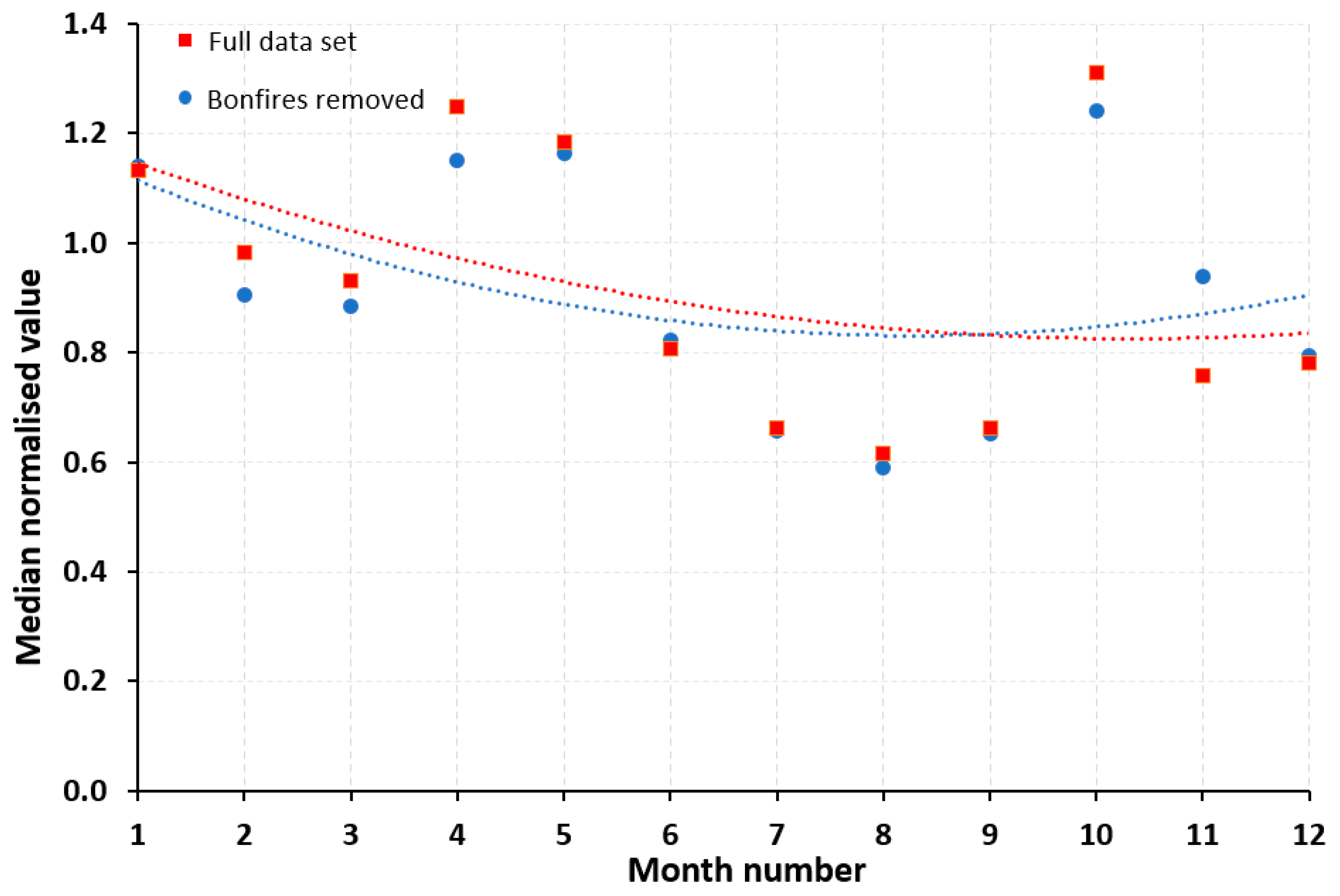

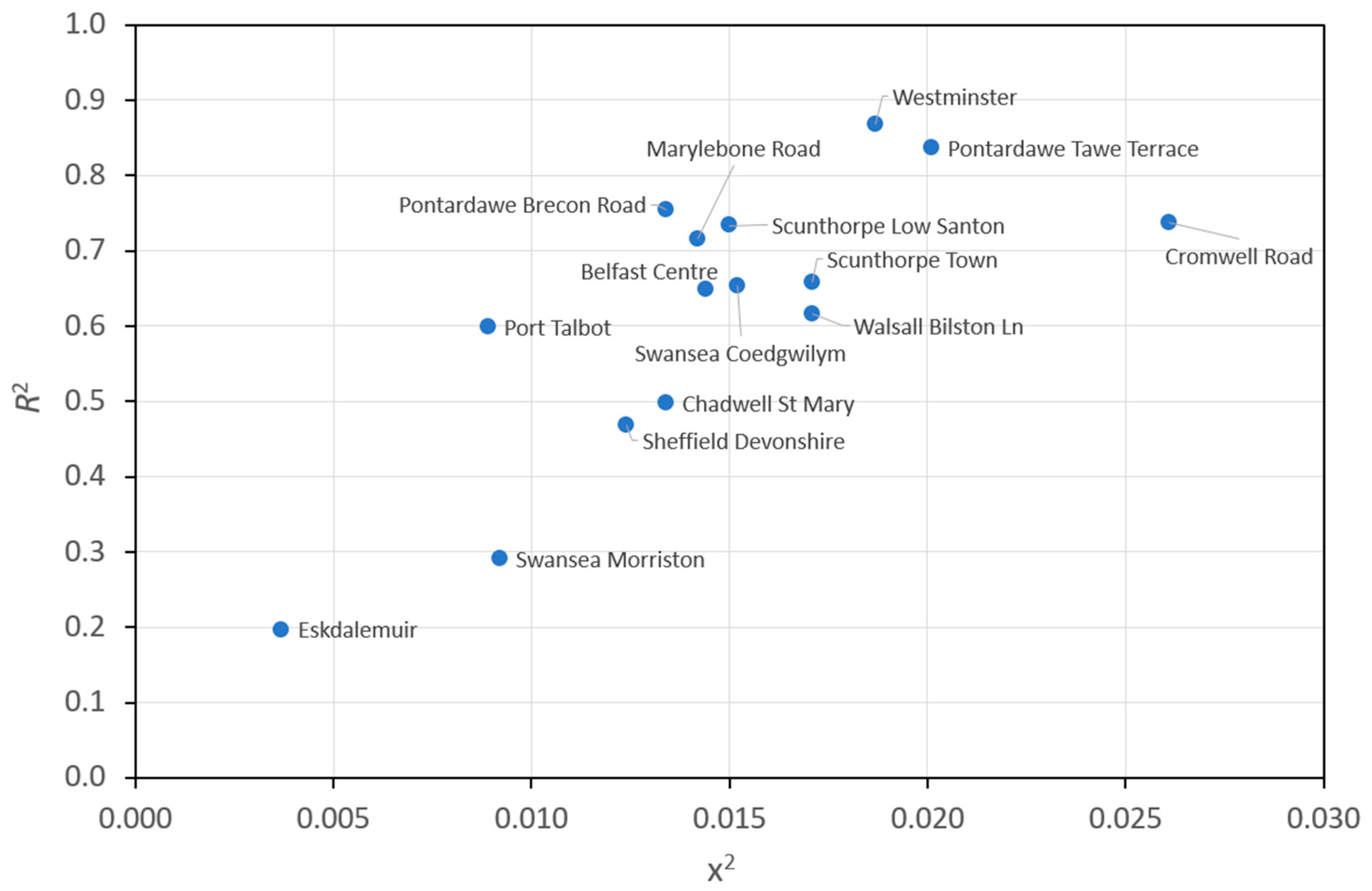
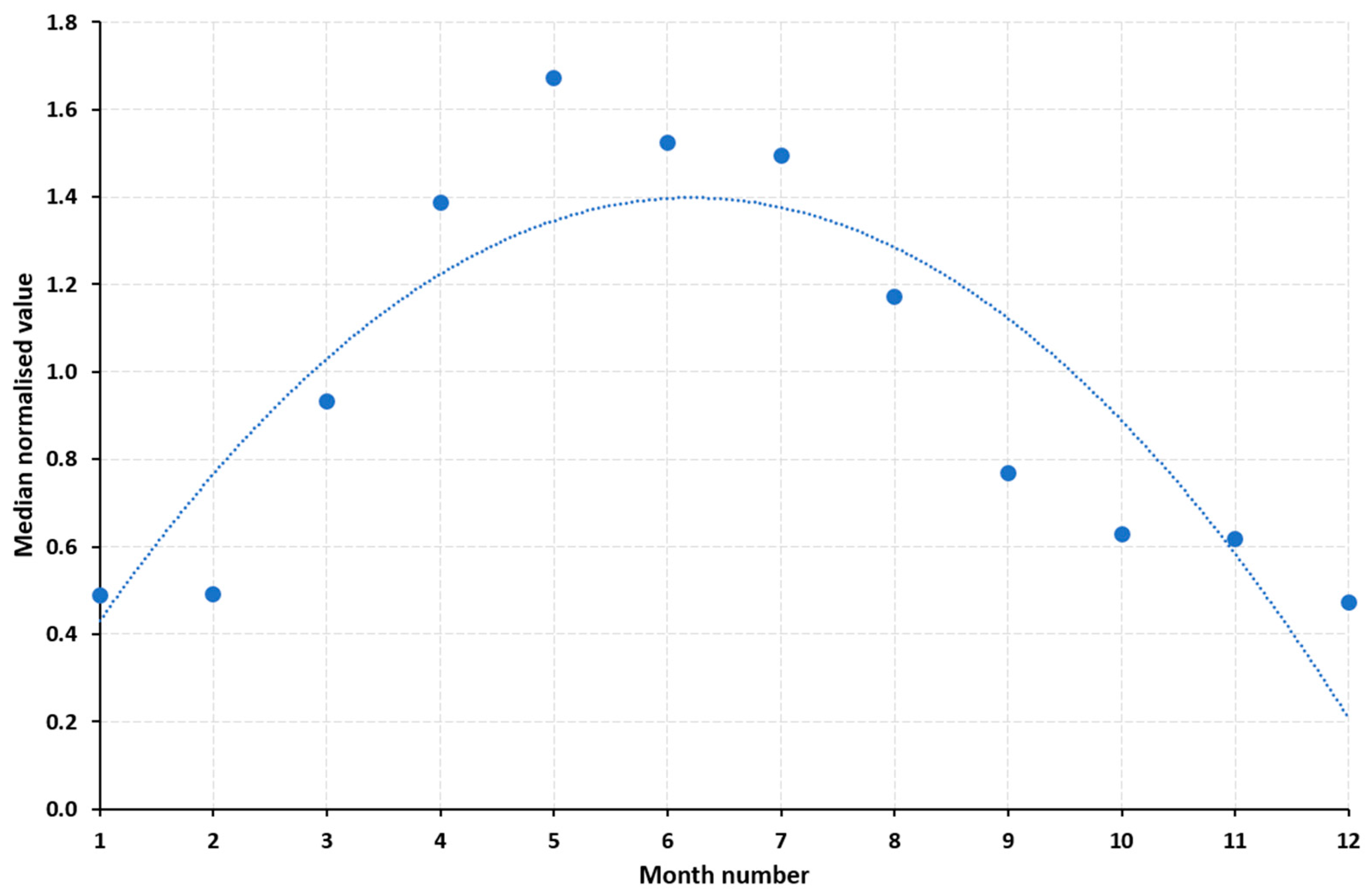

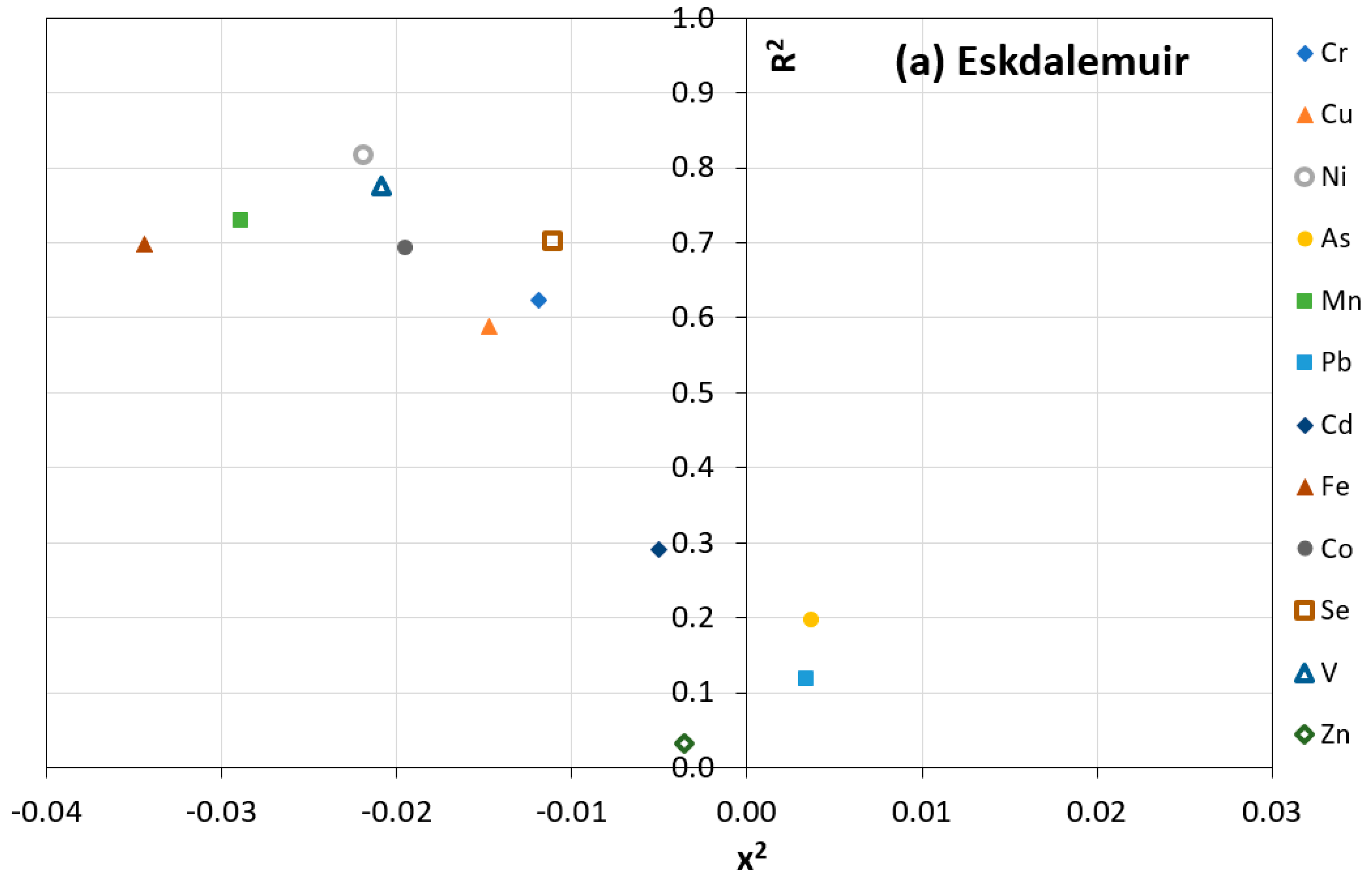
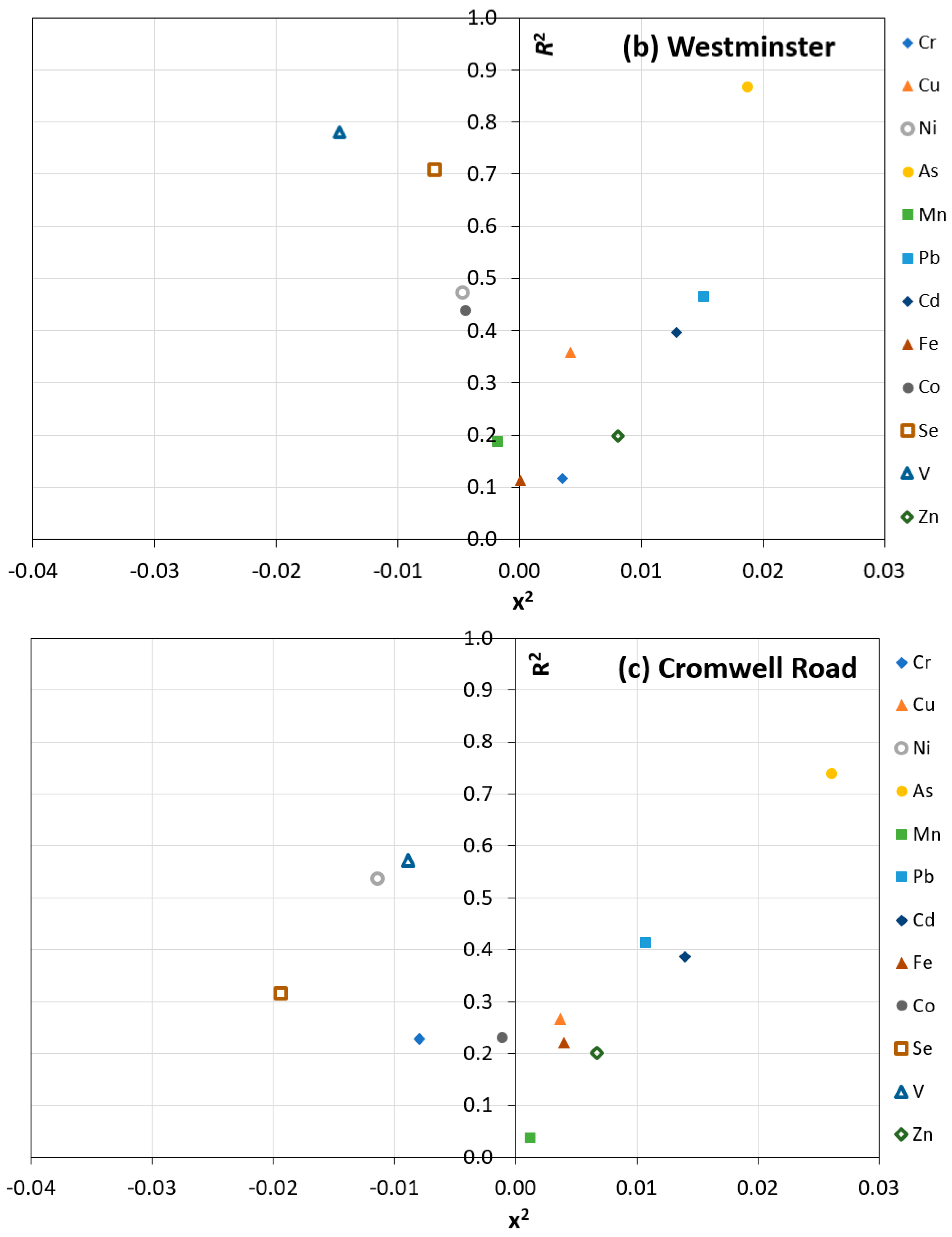
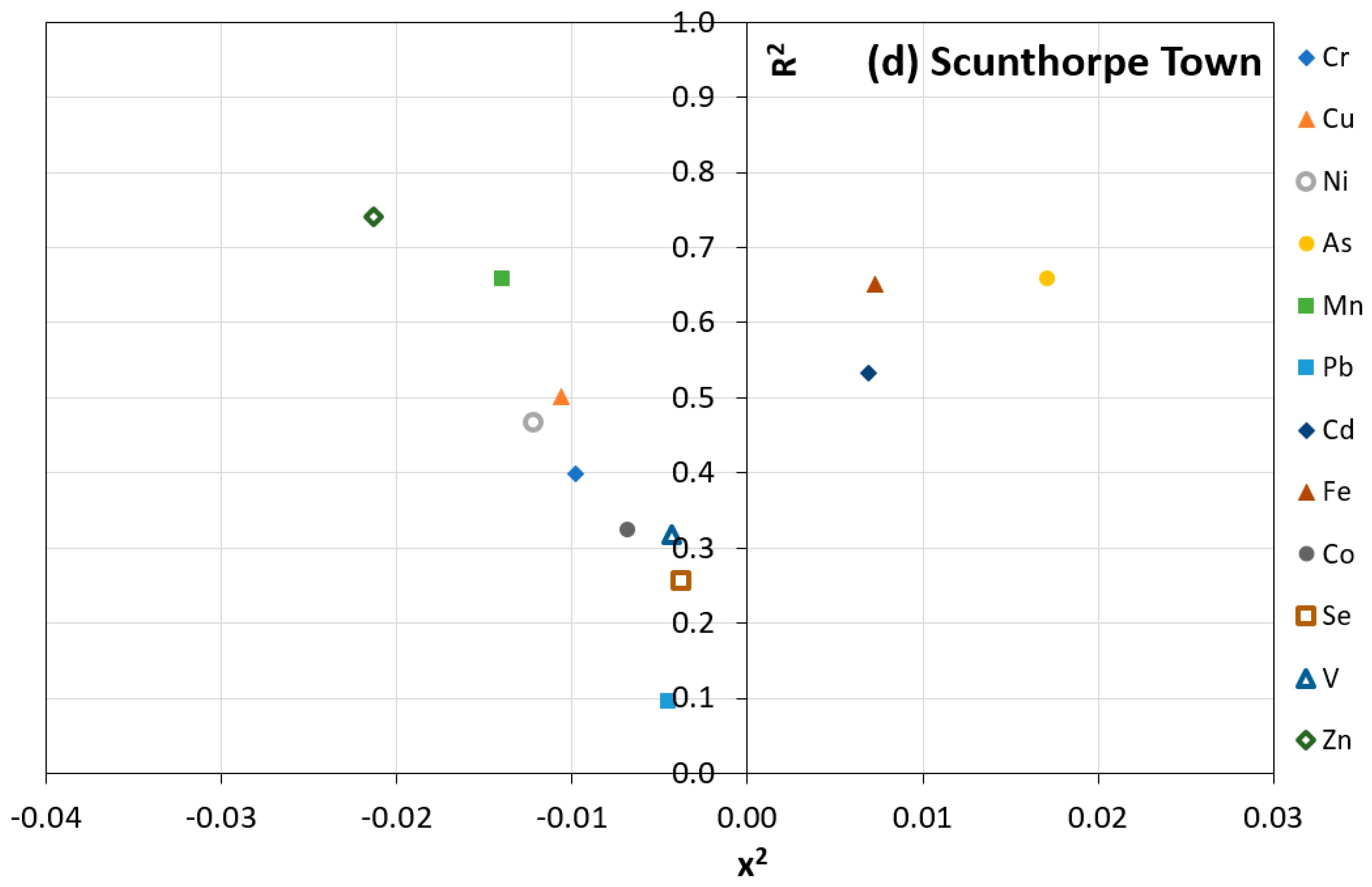
| Monitoring Station | Data Used from | Data Used to | Latitude | Longitude | Country | Type |
|---|---|---|---|---|---|---|
| Belfast Centre | 01/01/2010 | 31/12/2022 | 54.59965 | −5.92883 | Northern Ireland | Urban Background |
| Chadwell St Mary | 01/01/2010 | 31/12/2022 | 51.48196 | 0.37021 | England | Urban Background |
| Cromwell Road | 01/01/2005 | 31/12/2013 | 51.49548 | −0.17871 | England | Urban Traffic |
| Eskdalemuir | 01/01/2005 | 31/12/2022 | 55.31531 | −3.20611 | Scotland | Rural Background |
| London Marylebone Road | 01/04/2011 | 31/12/2022 | 51.52253 | −0.15461 | England | Urban Traffic |
| London Westminster | 01/01/2005 | 31/12/2022 | 51.49467 | −0.13193 | England | Urban Background |
| Pontardawe Brecon Road | 11/08/2011 | 31/12/2022 | 51.72651 | −3.84344 | Wales | Suburban Industrial |
| Pontardawe Tawe Terrace | 01/01/2011 | 31/12/2022 | 51.72001 | −3.84722 | Wales | Urban Industrial |
| Port Talbot Margam | 01/01/2010 | 31/12/2022 | 51.58395 | −3.77082 | Wales | Urban Industrial |
| Scunthorpe Low Santon | 01/01/2010 | 31/12/2022 | 53.59583 | −0.59724 | England | Suburban Industrial |
| Scunthorpe Town | 01/01/2010 | 31/12/2022 | 53.58634 | −0.63681 | England | Urban Industrial |
| Sheffield Devonshire Green * | 01/01/2010 | 31/12/2022 | 53.37862 | −1.47810 | England | Urban Background |
| Swansea Coedgwilym | 01/01/2010 | 31/12/2022 | 51.70168 | −3.87401 | Wales | Urban Background |
| Swansea Morriston | 01/01/2010 | 31/12/2022 | 51.66212 | −3.92130 | Wales | Urban Traffic |
| Walsall Bilston Lane | 01/01/2005 | 29/08/2018 | 52.58313 | −2.04280 | England | Urban Industrial |
| (a) | ||||||||||||
| Monitoring Station | As | Pb | Zn | Cd | Cu | Fe | ||||||
| x2 | R2 | x2 | R2 | x2 | R2 | x2 | R2 | x2 | R2 | x2 | R2 | |
| Cromwell Road | 0.0253 | 0.556 | 0.0122 | 0.469 | 0.0058 | 0.164 | 0.0128 | 0.349 | 0.0028 | 0.214 | 0.0030 | 0.260 |
| Pontardawe Tawe Terrace | 0.0211 | 0.770 | 0.0084 | 0.439 | 0.0039 | 0.204 | −0.0061 | 0.234 | 0.0105 | 0.599 | 0.0034 | 0.080 |
| Walsall Bilston Lane | 0.0192 | 0.555 | 0.0136 | 0.609 | 0.0132 | 0.576 | 0.0095 | 0.417 | 0.0099 | 0.453 | 0.0000 | 0.338 |
| Westminster | 0.0190 | 0.689 | 0.0119 | 0.585 | 0.0082 | 0.213 | 0.0107 | 0.363 | 0.0042 | 0.334 | −0.0008 | 0.068 |
| Scunthorpe Town | 0.0174 | 0.472 | −0.0051 | 0.168 | −0.0213 | 0.818 | 0.0070 | 0.221 | −0.0107 | 0.448 | 0.0107 | 0.437 |
| Swansea Coedgwilym | 0.0173 | 0.676 | 0.0136 | 0.659 | 0.0009 | 0.019 | −0.0014 | 0.079 | 0.0101 | 0.736 | −0.0023 | 0.083 |
| Scunthorpe Low Santon | 0.0164 | 0.616 | 0.0060 | 0.250 | 0.0084 | 0.369 | 0.0053 | 0.217 | 0.0061 | 0.323 | 0.0020 | 0.138 |
| Pontardawe Brecon Road | 0.0154 | 0.762 | 0.0091 | 0.239 | 0.0001 | 0.106 | −0.0037 | 0.082 | 0.0020 | 0.403 | −0.0011 | 0.052 |
| Chadwell St Mary | 0.0140 | 0.371 | 0.0096 | 0.443 | 0.0062 | 0.222 | 0.0067 | 0.269 | 0.0085 | 0.387 | −0.0009 | 0.068 |
| Sheffield Devonshire | 0.0139 | 0.413 | 0.0093 | 0.228 | 0.0028 | 0.087 | 0.0031 | 0.024 | 0.0091 | 0.499 | −0.0008 | 0.027 |
| Marylebone Road | 0.0139 | 0.589 | 0.0090 | 0.372 | 0.0031 | 0.155 | 0.0073 | 0.266 | −0.0039 | 0.536 | −0.0018 | 0.456 |
| Swansea Morriston | 0.0103 | 0.263 | 0.0058 | 0.305 | 0.0029 | 0.216 | 0.0000 | 0.266 | 0.0078 | 0.720 | 0.0081 | 0.541 |
| Port Talbot | 0.0093 | 0.613 | −0.0075 | 0.535 | 0.0071 | 0.704 | −0.0076 | 0.324 | −0.0022 | 0.495 | −0.0196 | 0.602 |
| Belfast Centre | 0.0067 | 0.182 | −0.0045 | 0.038 | −0.0188 | 0.192 | −0.0008 | 0.004 | 0.0045 | 0.433 | −0.0038 | 0.153 |
| Eskdalemuir | 0.0054 | 0.165 | 0.0048 | 0.070 | −0.0003 | 0.005 | −0.0060 | 0.243 | −0.0135 | 0.549 | −0.0361 | 0.699 |
| (b) | ||||||||||||
| Monitoring Station | Cr | Co | Se | Ni | Mn | V | ||||||
| x2 | R2 | x2 | R2 | x2 | R2 | x2 | R2 | x2 | R2 | x2 | R2 | |
| Cromwell Road | −0.0087 | 0.264 | −0.0005 | 0.034 | −0.0202 | 0.291 | −0.0134 | 0.603 | −0.0002 | 0.075 | −0.0108 | 0.661 |
| Pontardawe Tawe Terrace | −0.0022 | 0.023 | −0.0048 | 0.156 | −0.0069 | 0.724 | −0.0084 | 0.348 | −0.0075 | 0.305 | −0.0162 | 0.675 |
| Walsall Bilston Lane | −0.0036 | 0.043 | −0.0002 | 0.007 | −0.0032 | 0.184 | 0.0033 | 0.392 | 0.0047 | 0.133 | −0.0058 | 0.341 |
| Westminster | 0.0035 | 0.126 | −0.0035 | 0.315 | −0.0068 | 0.665 | −0.0048 | 0.642 | −0.0025 | 0.227 | −0.0158 | 0.772 |
| Scunthorpe Town | −0.0083 | 0.437 | −0.0073 | 0.478 | −0.0032 | 0.301 | −0.0142 | 0.684 | −0.0156 | 0.794 | −0.0055 | 0.329 |
| Swansea Coedgwilym | 0.0081 | 0.657 | 0.0112 | 0.703 | −0.0047 | 0.740 | 0.0091 | 0.482 | −0.0092 | 0.273 | −0.0152 | 0.728 |
| Scunthorpe Low Santon | −0.0113 | 0.477 | −0.0002 | 0.032 | 0.0052 | 0.221 | −0.0023 | 0.085 | −0.0150 | 0.575 | −0.0200 | 0.777 |
| Pontardawe Brecon Road | 0.0003 | 0.094 | 0.0010 | 0.155 | −0.0056 | 0.546 | 0.0066 | 0.669 | −0.0090 | 0.352 | −0.0144 | 0.745 |
| Chadwell St Mary | −0.0007 | 0.106 | −0.0073 | 0.383 | −0.0098 | 0.646 | −0.0065 | 0.510 | −0.0059 | 0.476 | −0.0139 | 0.742 |
| Sheffield Devonshire | −0.0042 | 0.422 | −0.0028 | 0.235 | −0.0088 | 0.229 | 0.0018 | 0.424 | −0.0092 | 0.548 | −0.0102 | 0.478 |
| Marylebone Road | −0.0021 | 0.327 | −0.0023 | 0.256 | −0.0056 | 0.347 | −0.0081 | 0.693 | −0.0030 | 0.553 | −0.0145 | 0.735 |
| Swansea Morriston | 0.0057 | 0.364 | −0.0052 | 0.169 | −0.0070 | 0.836 | 0.0016 | 0.097 | 0.0015 | 0.032 | −0.0115 | 0.581 |
| Port Talbot | −0.0057 | 0.186 | −0.0116 | 0.506 | −0.0079 | 0.689 | −0.0072 | 0.553 | −0.0193 | 0.696 | −0.0265 | 0.735 |
| Belfast Centre | −0.0059 | 0.100 | −0.0173 | 0.743 | 0.0021 | 0.116 | −0.0297 | 0.848 | −0.0077 | 0.415 | −0.0328 | 0.706 |
| Eskdalemuir | −0.0106 | 0.654 | −0.0206 | 0.697 | −0.0111 | 0.685 | −0.0239 | 0.801 | −0.0294 | 0.723 | −0.0230 | 0.823 |
| (a) | ||||||||||||
| Monitoring Station | As | Pb | Zn | Cd | Cu | Fe | ||||||
| x2 | R2 | x2 | R2 | x2 | R2 | x2 | R2 | x2 | R2 | x2 | R2 | |
| Cromwell Road | 0.0261 | 0.738 | 0.0108 | 0.413 | 0.0067 | 0.201 | 0.0140 | 0.386 | 0.0037 | 0.266 | 0.0040 | 0.221 |
| Pontardawe Tawe Terrace | 0.0201 | 0.837 | 0.0088 | 0.572 | 0.0033 | 0.291 | −0.0071 | 0.329 | 0.0094 | 0.618 | 0.0029 | 0.062 |
| Westminster | 0.0187 | 0.868 | 0.0151 | 0.465 | 0.0081 | 0.198 | 0.0129 | 0.397 | 0.0042 | 0.357 | 0.0001 | 0.112 |
| Walsall Bilston Lane | 0.0171 | 0.616 | 0.0113 | 0.308 | 0.0110 | 0.428 | 0.0053 | 0.083 | 0.0078 | 0.226 | −0.0006 | 0.245 |
| Scunthorpe Town | 0.0171 | 0.659 | −0.0045 | 0.096 | −0.0213 | 0.741 | 0.0069 | 0.533 | −0.0106 | 0.501 | 0.0073 | 0.652 |
| Swansea Coedgwilym | 0.0152 | 0.653 | 0.0134 | 0.661 | −0.0008 | 0.082 | −0.0019 | 0.160 | 0.0093 | 0.714 | −0.0024 | 0.080 |
| Scunthorpe Low Santon | 0.0150 | 0.734 | 0.0039 | 0.248 | 0.0070 | 0.360 | 0.0028 | 0.153 | 0.0040 | 0.195 | 0.0019 | 0.211 |
| Belfast Centre | 0.0144 | 0.648 | 0.0032 | 0.053 | −0.0056 | 0.446 | 0.0067 | 0.238 | 0.0036 | 0.422 | −0.0058 | 0.321 |
| Marylebone Road | 0.0142 | 0.716 | 0.0050 | 0.340 | 0.0026 | 0.122 | 0.0080 | 0.322 | −0.0047 | 0.493 | −0.0030 | 0.466 |
| Pontardawe Brecon Road | 0.0134 | 0.754 | 0.0083 | 0.253 | −0.0007 | 0.140 | −0.0049 | 0.197 | 0.0018 | 0.433 | −0.0014 | 0.038 |
| Chadwell St Mary | 0.0134 | 0.498 | 0.0111 | 0.608 | 0.0059 | 0.242 | 0.0057 | 0.359 | 0.0077 | 0.456 | −0.0009 | 0.114 |
| Sheffield Devonshire | 0.0124 | 0.469 | 0.0076 | 0.323 | −0.0013 | 0.303 | 0.0007 | 0.236 | 0.0076 | 0.524 | −0.0014 | 0.102 |
| Swansea Morriston | 0.0092 | 0.291 | 0.0045 | 0.347 | 0.0028 | 0.301 | −0.0030 | 0.473 | 0.0066 | 0.722 | 0.0090 | 0.522 |
| Port Talbot | 0.0089 | 0.599 | −0.0086 | 0.626 | 0.0060 | 0.429 | −0.0080 | 0.262 | −0.0039 | 0.462 | −0.0196 | 0.602 |
| Eskdalemuir | 0.0037 | 0.197 | 0.0034 | 0.119 | −0.0036 | 0.032 | −0.0050 | 0.290 | −0.0147 | 0.588 | −0.0344 | 0.699 |
| (b) | ||||||||||||
| Monitoring Station | Cr | Co | Se | Ni | Mn | V | ||||||
| x2 | R2 | x2 | R2 | x2 | R2 | x2 | R2 | x2 | R2 | x2 | R2 | |
| Cromwell Road | −0.0079 | 0.229 | −0.0011 | 0.230 | −0.0194 | 0.316 | −0.0114 | 0.538 | 0.0012 | 0.036 | −0.0089 | 0.571 |
| Pontardawe Tawe Terrace | −0.0027 | 0.035 | −0.0035 | 0.133 | −0.0069 | 0.673 | −0.0084 | 0.349 | −0.0076 | 0.283 | −0.0167 | 0.701 |
| Westminster | 0.0035 | 0.117 | −0.0044 | 0.439 | −0.0070 | 0.709 | −0.0047 | 0.475 | −0.0018 | 0.187 | −0.0148 | 0.780 |
| Walsall Bilston Lane | 0.0057 | 0.117 | −0.0015 | 0.095 | −0.0043 | 0.374 | 0.0016 | 0.241 | 0.0030 | 0.066 | −0.0050 | 0.348 |
| Scunthorpe Town | −0.0098 | 0.398 | −0.0068 | 0.324 | −0.0038 | 0.257 | −0.0122 | 0.467 | −0.0140 | 0.658 | −0.0043 | 0.318 |
| Swansea Coedgwilym | 0.0084 | 0.700 | 0.0116 | 0.706 | −0.0053 | 0.682 | 0.0092 | 0.522 | −0.0087 | 0.236 | −0.0149 | 0.739 |
| Scunthorpe Low Santon | −0.0109 | 0.431 | −0.0010 | 0.025 | 0.0063 | 0.404 | −0.0041 | 0.346 | −0.0154 | 0.556 | −0.0195 | 0.695 |
| Belfast Centre | −0.0086 | 0.150 | −0.0203 | 0.800 | 0.0011 | 0.082 | −0.0315 | 0.796 | −0.0084 | 0.493 | −0.0356 | 0.768 |
| Marylebone Road | −0.0023 | 0.305 | −0.0016 | 0.251 | −0.0049 | 0.287 | −0.0078 | 0.675 | −0.0035 | 0.437 | −0.0149 | 0.783 |
| Pontardawe Brecon Road | 0.0004 | 0.103 | 0.0010 | 0.119 | −0.0054 | 0.560 | 0.0056 | 0.441 | −0.0096 | 0.405 | −0.0138 | 0.712 |
| Chadwell St Mary | −0.0042 | 0.075 | −0.0083 | 0.525 | −0.0093 | 0.652 | −0.0059 | 0.408 | −0.0058 | 0.474 | −0.0138 | 0.768 |
| Sheffield Devonshire | −0.0042 | 0.431 | −0.0041 | 0.245 | −0.0096 | 0.219 | 0.0011 | 0.491 | −0.0092 | 0.571 | −0.0103 | 0.507 |
| Swansea Morriston | 0.0061 | 0.362 | −0.0042 | 0.160 | −0.0070 | 0.823 | 0.0018 | 0.089 | 0.0021 | 0.033 | −0.0114 | 0.584 |
| Port Talbot | −0.0065 | 0.278 | −0.0122 | 0.516 | −0.0083 | 0.613 | −0.0076 | 0.586 | −0.0190 | 0.748 | −0.0262 | 0.735 |
| Eskdalemuir | −0.0119 | 0.623 | −0.0195 | 0.693 | −0.0111 | 0.703 | −0.0219 | 0.817 | −0.0289 | 0.729 | −0.0209 | 0.776 |
| Emission Source | Percentage |
|---|---|
| Costal—Fuel oil | 8% |
| Costal—Gas oil | 10% |
| Naval—Gas oil | 1% |
| International maritime navigation—Fuel oil | 69% |
| International maritime navigation—Gas oil | 12% |
Disclaimer/Publisher’s Note: The statements, opinions and data contained in all publications are solely those of the individual author(s) and contributor(s) and not of MDPI and/or the editor(s). MDPI and/or the editor(s) disclaim responsibility for any injury to people or property resulting from any ideas, methods, instructions or products referred to in the content. |
© 2024 by the authors. Licensee MDPI, Basel, Switzerland. This article is an open access article distributed under the terms and conditions of the Creative Commons Attribution (CC BY) license (https://creativecommons.org/licenses/by/4.0/).
Share and Cite
Butterfield, D.M.; Brown, R.J.C.; Brown, A.S. Seasonality of Heavy Metal Concentrations in Ambient Particulate Matter in the UK. Atmosphere 2024, 15, 636. https://doi.org/10.3390/atmos15060636
Butterfield DM, Brown RJC, Brown AS. Seasonality of Heavy Metal Concentrations in Ambient Particulate Matter in the UK. Atmosphere. 2024; 15(6):636. https://doi.org/10.3390/atmos15060636
Chicago/Turabian StyleButterfield, David M., Richard J. C. Brown, and Andrew S. Brown. 2024. "Seasonality of Heavy Metal Concentrations in Ambient Particulate Matter in the UK" Atmosphere 15, no. 6: 636. https://doi.org/10.3390/atmos15060636
APA StyleButterfield, D. M., Brown, R. J. C., & Brown, A. S. (2024). Seasonality of Heavy Metal Concentrations in Ambient Particulate Matter in the UK. Atmosphere, 15(6), 636. https://doi.org/10.3390/atmos15060636







